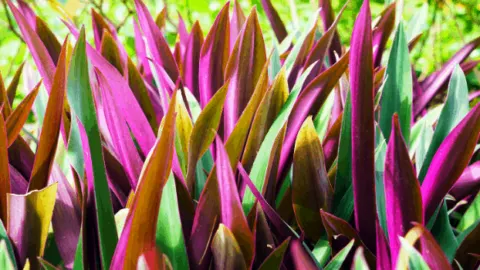The Oyster plant, or Tradescantia spathacea, is a member of the Commelinaceae family.
These plants are commonly known as spiderworts, a group of tropical and subtropical herbs.
The names “Sea dock”, “Sea bluebells”, and the “Oyster plant” may lead you to believe that this plant resembles characteristics of the ocean.
The only marine-like attributes are the bracts that hold onto the flowers since they resemble little boats.
These houseplants are known for their iconic leaves that sport purple, green, pink, and white tones.
Tradescantia spathacea is classified as an invasive species in the South by the IFAS (Invasive Plants Working Group) according to the Univesity of Florida.
So it is best to care for the Oyster plant as a houseplant.
Oyster Plant Care
To care for an Oyster plant provide a temperature between 55-80°F (13-27°F) and rich well-draining soil and bright indirect light. Water about once a week and ensure a humidity >40%. Fertilize once a month in spring and summer using a diluted liquid fertilizer at 1/2 strength.

Oyster Plant Care
They are considered to be easy houseplants, making them a great candidate for someone wanting to bring in a unique flora.
Table of Contents
Oyster Plant Care Guide
Described by many as having a “no-fuss nature”, the Oyster plant is a fun addition for its smaller size and interesting foliage.
They do have some preferences, which we’ve provided below.

Oyster Plant Care
SOIL
An Oyster plant grows best in rich soil that can drain properly will most likely yield the best results.
Without the proper soil and drainage, Oyster plants fall privy to problems with their root and leaf systems.
They can handle a surprisingly wide range of soil types including acidic, basic, loam, clay, and sand.
If you can combine potting soil with compost and perlite, you’ll have a very happy Oyster plant.
LIGHT
The Oyster plant prefers bright indirect light.
Found in the tropical regions of Mexico, Guatemala, and Belize, Tradescantia spathacea is used to bright light.
In their natural habitat, they compete with taller trees and shrubs in the understory.
This means that they tolerate anything from medium to bright light, even surviving when placed in an area with partial shade.
As long as they aren’t placed in bright, direct light, your Oyster plant should thrive just fine.
Too much sun exposure can lead to the leaves becoming burned, resulting in diluted colors.
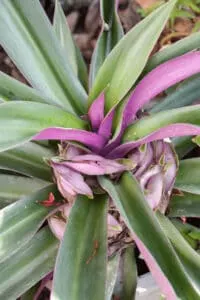
Bright indirect light is best for an Oyster plant
WATERING
On average, you can expect to water your Oyster plant once a week.
Tradescantia spathacea is relatively prepared when it comes to drought, being able to handle stints with a lack of water.
They do prefer to be thoroughly saturated as long as they can drain properly.
If the roots sit in water for too long, there can be long-term damage.
The watering schedule tends to shift based on the time of year and the conditions of your home.
We will discuss the specifics about how much and when to increase the moisture content later on.
TEMPERATURE
The ideal temperature range for an Oyster plant is between 55-80 degrees Fahrenheit (13 and 27 degrees Celsius).
The average indoor temperature should be more than enough for an Oyster plant to stay happy.
In reality, you just don’t want it to be exposed to temperatures that drop below 10 degrees Celsius.
Being from the tropical regions, Oyster plants aren’t as resistant to colder temperatures.
Fortunately, this is relatively easy when raising them indoors. Outdoor individuals usually have to be brought inside during the fall and winter months.
HUMIDITY
The Oyster plant grows best in humidity >40%.
Given their natural habitat, it’s not very surprising that they prefer higher percentages of humidity.
Don’t worry.
You don’t have to turn your house into a sauna.
Most Tradescantia spathacea specimens favor moderate to high levels of humidity. Anything above about forty percent should suffice.
There are a number of ways that you can increase the moisture in the air of your home without making drastic changes.
Misting is among the easier techniques.
Another method involves placing your potted plant onto a tray lined with pebbles so that the water evaporates.
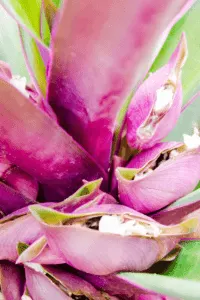
FERTILIZER
Fertilize the Oyster plant once a month in the growing season using a liquid fertilizer diluted to 1/2 strength.
The use of fertilizer is to provide the plant with additional nutrients, especially in the hopes of developing impressive blooms.
The Oyster plant does have flowers, though they are relatively small when compared to other houseplants.
For this reason, you can choose to opt-out of this process if you’re fine with the results.
If you do want to implement a food routine, it should be done with a mild, diluted solution that is water-soluble.
Only add it once a month during the growing seasons. Any more is unnecessary.
Curious about the nutrients that plants need and how fertilizer can help? We have an article concerning Fertilization 101.
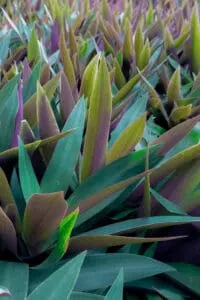
Fertilize once a month with a diluted fertilizer at half strength
PROPAGATION
There are three common methods associated with propagating an Oyster plant. These include division, stem cuttings, or seedlings.
Choosing to get new individuals out of seedlings can be a lengthier process than stem cuttings or division.
Most plant enthusiasts would advocate for stem cuttings as the best technique involving propagation. We will list off the steps later on in this text so that you can try it at home!
GROWTH
Oyster plants typically reach anywhere between six and twelve inches in overall height (15-30cm).
The leaves themselves make up a majority of that mass in lance-like structures.
Each of them is about the same lengthwise as the plant is tall, with a width of up to twelve inches.
It only takes them about a year or two to get to this height. They are pretty quick in terms of their growth rate.
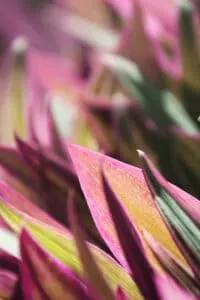
Oyster plants can grow to a height between between six and twelve inches in overall height (15-30cm)
POTTING
Repotting is fairly essential for the Oyster plant. The roots can become cramped within the container, soon needing to be replanted to a new container.
Some plants are relatively tricky when it comes to this process, but not Tradescantia spathacea.
Handling them with a little more gusto shouldn’t be a problem as long as you are mindful of the roots.
Repotting typically needs to happen every few years.
You should choose a pot that is slightly larger than your previous container.
It’s best to only repot if the Oyster plant needs it. Too much movement can cause the flora to become stressed.
PROVIDING WATER FOR YOUR OYSTER PLANT
Watering your Oyster plant isn’t all that tricky. It likes the soil to be fairly saturated, just as long as it doesn’t sit in water.
This will cause the roots to rot, leading to problems later down the line.
Allowing your plant to dry out between watering sessions can be beneficial. Don’t let it go too long, however. It should only be until the first inch of soil is dry.
You’ll want to adjust the amount of water that you give to your Oyster plant depending on the season.
Winter months don’t require as frequent watering.
During this time, you can reduce our efforts to once a week, sometimes even every other week.
The warmer seasons usually demand that you water your flora once a week at the very least.
Keep an eye on the soil and foliage, and you should be just fine!
PROPAGATING AN OYSTER PLANT
You can propagate a Tradescantia spathacea through the act of seedlings, division, or stem cuttings.
All of these methods are relatively easy, though we’ve found stem cuttings to yield the best results.
The following section is devoted to the steps involved with propagating your Oyster plant through stem cuttings.
PROPAGATION THROUGH STEM CUTTINGS
- Choose the right plant that you want to propagate and continue with this process during the early spring where it will grow more quickly.
- Locate the side shoots, cutting off any that are about two to four inches in length.
- Take these shoots and place them into pots with fresh soil.
- Continue to take care of the shoots by covering them with plastic.
- Place the covered stem cuttings into a shaded area of the house that gets plenty of warmth.
- Continue to water once a week until you see new shoots emerge, which should happen within a few months.
OYSTER PLANT PEST ISSUES
Unfortunately, the leaves of an Oyster plant are relatively appealing to pests, both bugs, and fungal infections.
But don’t worry since there are a number of solutions that can combat such problems if you ever happen across them.
The main bugs that you would find eating away at the foliage on your Oyster plant are mealybugs, mites, caterpillars, and scale insects.
Hosing them off can be beneficial if you’re diligent in your efforts. You can also opt for an insecticide.
Do your research and learn which method would work best for the type of bug is infecting your plant.
Other infestations include fungus, leaf spot, and root rot. Each of these takes a specific remedy.
Fungicides will work on both leaf spot and fungus as long as it is used correctly.
Root rot takes a little extra care. Typically, plant owners will replant the plant after carefully washing the roots with tap water.

Pests are attracted to the Oyster plant and its delicious leaves
OYSTER PLANT SIGNS OF DISTRESS
One way that we have learned to take care of living beings is to look at physical changes.
For instance, dogs will whimper to tell us if something is off. Plants do the same, in their own way.
By noticing differences in the leaves, stems, or overall appearance, you can combat a number of issues before they turn deadly.
TELLTALE SIGN #1: CURLING OF LEAVES
Cause: Normally, the foliage of an Oyster plant is rigid. The curling of the leaves may signal that the flora isn’t getting an adequate amount of water.
Remedy: Increase your watering schedule, carefully watching to see if the plant is sitting in water. You can also do this more gradually through misting.
TELLTALE SIGN #2: BROWN COLORATION
Cause: The shifting of a brilliant purple tone to an overall tone can be due to a few problems. Either your plant is getting too much sun, or there isn’t enough water.
Remedy: We would suggest that you try to simply move your Oyster plant to a spot with less direct sunlight before moving on to the second potential issue. If that doesn’t work, gradually increase the watering frequency.
TELLTALE SIGN #3: DROOPING FOLIAGE
Cause: Tradescantia spathacea can be seen wilting if there is too much direct sunlight.
Remedy: In this instance, it is best to decide on a new location, preferably one that isn’t directly exposed to sunlight.
TELLTALE SIGN #4: WHITE SPOTS
Cause: You may notice white spots covering the top layer of leaves that make up your Oyster plant. Spider mites are likely to blame for such discoloration.
Remedy: Spider mite infestations should be dealt with quickly. You can tackle this issue by hosing down the plant with a high enough water pressure.
HAPPY OYSTER PLANT TIPS AND TRICKS
We understand that there was a lot of information discussed in this article. To make it easier, we’ve decided to compile the top five pieces that you can use to keep your Oyster plant happy.
- Use a rich, well-draining soil that has organic materials such as compost and perlite for the best results.
- Choose a spot in your house that gets plenty of sunlight, as long as it isn’t direct.
- Try to avoid allowing drafts to enter your home, keeping the temperature between 13 and 27 degrees Celsius.
- Ensure that there is moderate to heavy humidity through additional misting!
- Water your Oyster plant once a week and make sure that the excess moisture can be drained properly.
FREQUENTLY ASKED QUESTION ABOUT OYSTER PLANT CARE
Are Oyster plants toxic?
This plant is toxic when consumed, as the sap within the leaves can cause negative affects. Surprisingly, this flora has been used for medicinal purposes, meaning that it can be consumed when prepared properly.
Can Oyster plants get leggy?
Oyster plants can become leggy, though it isn’t quite as obvious as with other species of flowering species. Fixing this only takes a few snips with clean scissors.
What is an Oyster plant good for?
These plants are ideal for anyone who wants a smaller tropical houseplant that requires little maintenance. They adorn smaller spaces with a fun pop of color.

Daniel has been a plant enthusiast for over 20 years. He owns hundreds of houseplants and prepares for the chili growing seasons yearly with great anticipation. His favorite plants are plant species in the Araceae family, such as Monstera, Philodendron, and Anthurium. He also loves gardening and is growing hot peppers, tomatoes, and many more vegetables.

